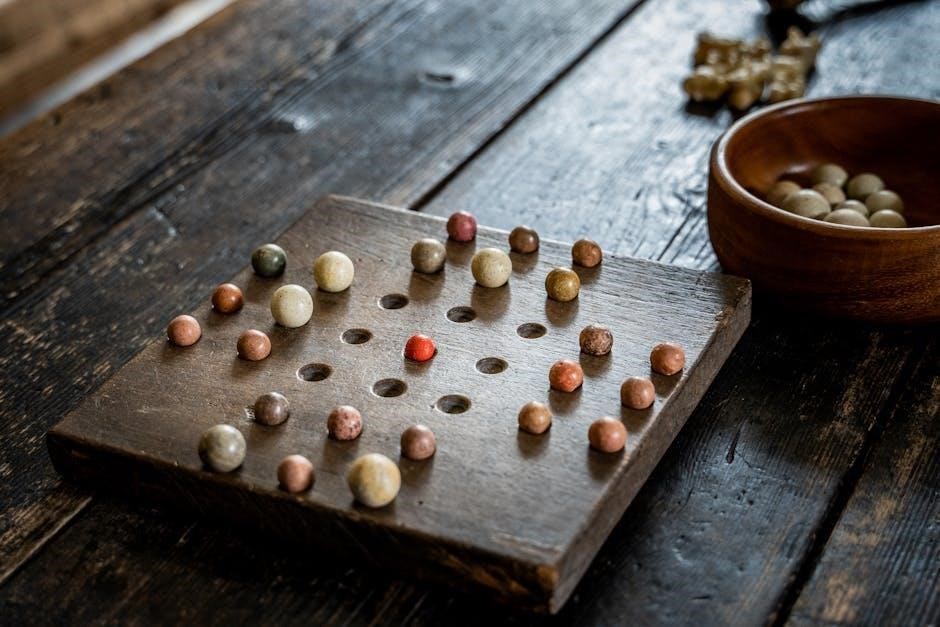Welcome to the world of Solitaire! This guide provides a comprehensive overview of Solitaire‚ including its rules‚ strategies‚ and variations. Perfect for beginners‚ it offers step-by-step instructions and visual aids to help you master the game. Whether you’re new to Solitaire or looking to refine your skills‚ this PDF is your ultimate resource.
1.1 What is Solitaire PDF?
A Solitaire PDF is a digital guide that provides comprehensive information about the classic card game Solitaire. It includes detailed rules‚ strategies‚ and variations of the game‚ making it an invaluable resource for players of all skill levels. These PDFs often feature step-by-step instructions‚ visual aids‚ and tips to help users master Solitaire. Whether you’re a beginner looking to learn the basics or an experienced player seeking advanced techniques‚ a Solitaire PDF offers a structured and accessible way to enhance your understanding and enjoyment of the game.
1.2 Importance of Solitaire PDF for Beginners
A Solitaire PDF is an essential resource for beginners‚ offering clear‚ structured guidance to learn the game. It provides step-by-step instructions‚ visual aids‚ and practice exercises to help new players understand the rules and strategies. By breaking down complex concepts into simple‚ digestible sections‚ a Solitaire PDF ensures beginners can grasp the fundamentals without confusion. It also offers tips to improve gameplay‚ making it an invaluable tool for anyone looking to master Solitaire confidently and efficiently. This resource is perfect for those seeking a comprehensive yet easy-to-follow guide to get started with the game.

Basic Rules of Solitaire
Solitaire involves moving cards to create four foundation piles‚ each suit from Ace to King. Players can move face-up cards and flip face-down ones to build sequences. The game requires strategic card placement and adherence to suit and rank rules to achieve victory. Understanding these rules is essential for mastering the game effectively and efficiently.
2.1 Objective of the Game
The primary objective of Solitaire is to move all 52 cards into four foundation piles‚ each organized by suit from Ace to King. Players achieve this by strategically relocating cards across the tableau and utilizing free cells. The game challenges patience and strategy‚ making it a beloved puzzle for many. Mastery requires understanding suit rotations and sequence building‚ which are essential for victory. Solitaire’s simplicity and depth make it a timeless favorite‚ offering hours of engaging gameplay.
2.2 Foundation Piles and Their Significance
The foundation piles are central to Solitaire‚ serving as the ultimate destination for all cards. There are four piles‚ one for each suit (hearts‚ diamonds‚ clubs‚ and spades)‚ and each must be built from Ace to King in ascending order. Only an Ace can start a foundation pile‚ and each subsequent card must match the suit and follow the sequence. The foundation piles are crucial as they allow players to organize cards by suit and sequence‚ simplifying the game as it progresses. Building these piles efficiently is key to winning‚ as they help declutter the tableau and reveal hidden cards.
2.3 Tableau Columns and Card Placement
The tableau consists of seven columns‚ where the game is primarily played. The first column has one card‚ the second two‚ and so on‚ up to the seventh column with seven cards. The top card in each column is face-up‚ while the others are face-down. Cards in the tableau must be arranged in descending order‚ with each card placed on a higher-ranked card of the opposite color. Only the top card in a column can be moved‚ unless the entire pile is relocated. The tableau’s structure is crucial for revealing face-down cards and organizing the game effectively.

Setting Up the Game
Setting up Solitaire involves arranging the deck into seven columns‚ with the first column having one card and each subsequent column having one more card than the previous. The top card in each column is placed face-up‚ while the remaining cards are face-down. This setup creates the tableau‚ where the game is played‚ and allows players to begin moving cards according to the game’s rules.
3.1 Dealing the Deck into Seven Columns
Dealing the deck into seven columns is the first step in setting up Solitaire. Begin by placing one card face-up in the first column. Each subsequent column should have one more card than the previous‚ with the top card always face-up and the rest face-down. This results in the first column having one card‚ the second two‚ and so on‚ up to the seventh column‚ which has seven cards. A total of 28 cards are dealt‚ leaving the remaining 24 cards in the deck. This setup creates the tableau‚ where the game begins‚ and the foundation piles are built.
3.2 Face-Up and Face-Down Cards in the Tableau
In the tableau‚ the top card of each column is placed face-up‚ while the remaining cards in each column are face-down. This setup creates a balance between visible and hidden cards‚ allowing players to strategically plan their moves. Face-up cards can be immediately used for building foundation piles or moving within the tableau‚ while face-down cards must be revealed by removing the cards on top of them. This structure adds complexity to the game‚ as players must carefully uncover hidden cards to progress. The mix of face-up and face-down cards is essential to the gameplay and strategy of Solitaire.
3.4 Initial Card Arrangement
The initial card arrangement in Solitaire begins with dealing the deck into seven columns. The first column has one card‚ the second has two‚ and so on‚ up to seven cards in the seventh column. Each column’s top card is face-up‚ while the rest are face-down. The remaining cards are placed to the side as a stockpile. This setup creates the tableau‚ where players can start moving cards to build foundation piles or rearrange the tableau. The initial arrangement is crucial as it determines the starting point of the game and sets the stage for strategic moves to achieve victory.

Moving Cards in Solitaire
Moving cards in Solitaire involves strategic placement to achieve the game’s objective‚ utilizing face-up and foundation piles effectively for optimal and efficient gameplay.
4.1 Moving Face-Up Cards
Moving face-up cards is a core aspect of Solitaire. Players can move these cards between tableau columns or to foundation piles based on specific rules. Face-up cards can be placed on top of cards of the opposite color and one rank higher. For example‚ a red 3 can be placed on a black 4. Aces can be moved to start foundation piles‚ which are built up in suit from Ace to King. However‚ face-down cards cannot be moved until all face-up cards above them are cleared‚ ensuring strategic planning is essential for success. This rule enhances the game’s complexity and challenge.
4.2 Utilizing Foundation Piles
Foundation piles are essential in Solitaire‚ serving as the final resting place for cards. There are four foundation piles‚ one for each suit: hearts‚ diamonds‚ clubs‚ and spades. Each pile must be built in ascending order from Ace to King. Players can move an Ace to a foundation pile as soon as it appears‚ starting the sequence. Subsequently‚ cards of the same suit that are one rank higher than the top card of the foundation pile can be added. For example‚ a 3 of hearts can be placed on a 2 of hearts. Once a card is placed on a foundation pile‚ it cannot be moved again. This rule emphasizes strategic planning‚ as misplaced cards can hinder progress. Additionally‚ Solitaire features a suit rotation rule‚ where each foundation pile must follow a specific suit order: Club over Heart‚ Diamond over Club‚ Spade over Diamond‚ and Heart over Spade. Understanding and adhering to these rules is crucial for successfully moving cards to the foundation piles and ultimately winning the game.
4.3 Flipping Face-Down Cards
In Solitaire‚ face-down cards in the tableau can only be flipped when all face-up cards above them in their column have been moved. This rule ensures that players must carefully plan their moves to uncover hidden cards. To flip a face-down card‚ move the face-up cards on top of it to either the foundation piles or other tableau columns. This action reveals the hidden card‚ allowing it to be used in the game. Strategically flipping face-down cards is crucial for accessing more cards and progressing toward the game’s objective of moving all cards to the foundation piles. Proper management of face-up cards is essential to efficiently uncover and utilize face-down cards.

Solitaire Rules in Detail
Solitaire rules involve moving cards to build foundation piles from Ace to King‚ using suit rotation and ensuring only face-up cards are moved. Strategy is key.
5.1 Building Foundation Piles
Building foundation piles is central to winning Solitaire. These piles must be arranged by suit‚ starting with an Ace and ending with a King. Each foundation pile represents one of the four suits: hearts‚ diamonds‚ clubs‚ or spades. Cards must be placed in ascending order‚ and only the top card of each pile can be moved. Once a foundation pile is started with an Ace‚ you can only add cards of the same suit in sequential order. This structure ensures organization and progression toward the game’s objective.
5.2 Suit Rotation Rule
The suit rotation rule in Solitaire introduces a strategic layer by dictating the order of card placement. A Club must be placed over a Heart‚ a Diamond over a Club‚ a Spade on a Diamond‚ and a Heart on a Spade. This rotation applies to both the foundation piles and the tableau‚ adding complexity to the game. Players must carefully plan moves to adhere to this rule‚ ensuring cards are placed in the correct sequence. This rule requires attention to detail and forward thinking‚ making it a key element in mastering Solitaire strategy and achieving victory.
5.3 Prohibited Moves
In Solitaire‚ certain moves are strictly prohibited to maintain the game’s balance and challenge. Players cannot move face-down cards unless all face-up cards above them are removed. Additionally‚ cards cannot be relocated between foundation piles or moved from the foundation back to the tableau. Furthermore‚ placing a card on a foundation pile that disrupts the required suit sequence or rank order is not allowed. These restrictions ensure the game remains strategic and adherence to rules is essential for a valid win. Understanding prohibited moves is crucial to avoid invalidating your progress and ensuring a fair gameplay experience.

Advanced Strategies for Solitaire
Mastering Solitaire requires planning moves ahead‚ minimizing face-down cards‚ and efficiently using free cells. Advanced players prioritize building foundation piles and utilize suit rotation rules strategically.
6.1 Planning Moves Ahead
Planning moves ahead is crucial for success in Solitaire. Anticipate card placements and prioritize moving face-up cards strategically. Identify potential sequences and build foundations wisely to avoid blocking piles. Focus on uncovering hidden cards to maximize options. Efficient planning reduces wasted moves and increases chances of winning. Always consider the suit rotation rule to ensure smooth transitions between tableau and foundations. By thinking several steps ahead‚ players can optimize their strategy and achieve victory more consistently. This foresight is key to mastering the game.
6;2 Minimizing Face-Down Cards
Minimizing face-down cards is crucial for maintaining flexibility in Solitaire. Face-down cards can block access to other cards‚ limiting movement and strategy. To reduce them‚ prioritize flipping face-down cards by moving all face-up cards above them. Utilize free cells to temporarily hold cards‚ freeing up space in the tableau. Focus on columns with the most face-down cards first to uncover hidden cards. Regularly turning over face-down cards helps maintain a clearer tableau‚ allowing for better planning and execution of moves. Effective management of face-down cards is essential for advancing in the game and achieving victory.
6.3 Efficient Use of Free Cells
Free cells are a valuable resource in Solitaire‚ offering temporary storage for cards to free up space in the tableau. To use them efficiently‚ move face-up cards from the tableau to free cells when they block access to face-down cards or hinder movement. Prioritize cards that are close to being sequenced or suited for foundation piles. Avoid filling free cells with low-value cards that could be moved later. Instead‚ reserve them for strategic cards that unlock more moves. Regularly clear free cells by moving cards to foundation piles or the tableau. This ensures flexibility and improves your chances of winning the game.

Common Variations of Solitaire
Solitaire offers diverse variations‚ including Klondike‚ Spider‚ and Freecell. Each variation introduces unique rules and challenges‚ catering to different skill levels and player preferences for endless fun.
7.1 Klondike Solitaire
Klondike Solitaire‚ the most recognizable variation‚ is played with a standard 52-card deck. The game starts with seven tableau columns‚ each containing one to seven cards. The first column has one card‚ the second two‚ and so on‚ with the top card face-up and others face-down. The goal is to move all cards to four foundation piles‚ organized by suit from Ace to King. Players can move the top card of any pile and build sequences of alternating colors in the tableau. Klondike Solitaire is a classic and accessible version‚ perfect for newcomers to the game.
7.2 Spider Solitaire
Spider Solitaire is a challenging and engaging variation that requires skill and strategy. Played with two decks of 52 cards‚ it features ten tableau columns‚ with the first five containing five cards each and the remaining five containing four. The top card in each pile is face-up‚ and the goal is to create eight sequences of cards from King to Ace in the same suit. Players can move cards between columns to build these sequences‚ with the ability to use an additional deck as needed. Spider Solitaire offers a more complex experience‚ ideal for intermediate and advanced players seeking a greater challenge.
7.3 Freecell Solitaire
Freecell Solitaire is a popular variation known for its strategic depth and high win rate; Played with two decks of 52 cards‚ it features twelve columns: eight with six cards each and four empty “free cells.” These free cells act as temporary storage‚ allowing players to move cards and create sequences. The goal is to build four foundation piles‚ one for each suit‚ from Ace to King. Freecell offers more flexibility than Klondike‚ making it a favorite among experienced players. Its unique mechanics and high solvability make it a rewarding challenge for those looking to test their skills.

Solitaire PDF Resources
Discover essential Solitaire resources‚ including downloadable rule books‚ step-by-step guides‚ and printable PDFs. These tools help players master the game efficiently.
8.1 Downloadable Solitaire Rule Books
Downloadable Solitaire rule books in PDF format are excellent resources for learning and mastering the game. These guides provide detailed instructions‚ covering essential rules‚ strategies‚ and variations. Whether you’re a beginner or an experienced player‚ these PDFs offer a comprehensive understanding of Solitaire. They are easily accessible and can be printed for convenience. Many rule books include visual aids and step-by-step explanations‚ making it easier to grasp complex moves and techniques. These resources are ideal for anyone looking to improve their gameplay or explore different versions of Solitaire. They are user-friendly and designed to enhance your overall Solitaire experience.
8.2 Step-by-Step Guides
Step-by-step guides in Solitaire PDFs are designed to break down the game into manageable parts‚ making it easier for players to follow and understand. These guides detail every aspect of the game‚ from setting up the tableau to advanced strategies. They often include visual diagrams and clear instructions‚ ensuring that even newcomers can grasp the mechanics quickly. Many guides also provide tips for improving gameplay‚ such as optimizing card placement and minimizing face-down cards. By following these guides‚ players can enhance their skills and enjoy a more rewarding Solitaire experience. They are perfect for both beginners and those refining their techniques.
8.3 Printable Solitaire PDFs
Printable Solitaire PDFs offer a convenient way to access game rules‚ strategies‚ and setups offline. These documents are designed to be easy to read and print‚ ensuring you can take your Solitaire guide wherever you go. Many PDFs include diagrams‚ step-by-step instructions‚ and tips to enhance your gameplay. Whether you’re learning the basics or refining advanced techniques‚ printable PDFs provide a tangible resource to refer to whenever needed. They are ideal for players who prefer physical copies or want to practice without digital distractions. Printable Solitaire PDFs are a valuable tool for mastering the game at your own pace.

Learning Solitaire from PDF Guides
Learning Solitaire from PDF guides is an excellent way to grasp the game’s fundamentals. These guides offer detailed rules‚ strategies‚ and step-by-step instructions‚ making it easier to effectively understand and improve gameplay.
9.1 Benefits of Using PDF Guides
Solitaire PDF guides are an excellent resource for learning and improving your gameplay. They provide detailed rules‚ strategies‚ and step-by-step instructions‚ making it easy to understand complex moves. Visual aids like diagrams and examples help clarify game mechanics. Additionally‚ PDF guides are accessible offline‚ allowing you to practice anytime‚ anywhere. They cater to all skill levels‚ ensuring that both beginners and experienced players can benefit. These guides also offer tips for mastering advanced techniques and avoiding common mistakes‚ making them invaluable for anyone looking to enhance their Solitaire skills and enjoyment of the game.
9.2 Tips for Mastering Solitaire
Mastering Solitaire requires a mix of strategy and practice. Start by moving all face-up Aces to the foundation piles immediately. Plan your moves ahead to avoid blocking cards. Always minimize face-down cards in the tableau to maximize visibility. Use free cells wisely to temporarily store cards and free up space. Focus on building up foundation piles as soon as possible to improve your chances of winning. Regular practice and patience will help refine your skills and increase your success rate in the game.
9.3 Practice Exercises
Practice exercises are essential for improving your Solitaire skills. Start with simple challenges like moving all Aces to the foundation piles within the first ten moves. Gradually increase difficulty by focusing on specific strategies‚ such as minimizing face-down cards or efficiently using free cells. Set time limits to enhance decision-making speed. Try solving different game variations‚ like Klondike or Spider Solitaire‚ to broaden your expertise. Regularly reviewing game rules and strategies in your Solitaire PDF guide will also reinforce your learning and help you become a proficient player over time with consistent practice and dedication.
Solitaire PDF for Different Skill Levels
Solitaire PDF guides cater to all skill levels. Beginners can learn basic rules and strategies‚ while intermediate players can explore advanced techniques. Expert players will find challenging variations and complex strategies to refine their gameplay.
10.1 Beginners’ Guides
Beginners’ guides in Solitaire PDFs are designed to introduce new players to the game’s fundamentals. These guides typically include step-by-step instructions on setting up the game‚ understanding card placement‚ and basic rules. They explain how to move cards‚ build foundation piles‚ and utilize the tableau effectively. Many guides also provide visual aids‚ such as diagrams‚ to help learners grasp concepts like suit rotation and face-up/face-down card management. Practice exercises and tips for mastering initial moves are often included‚ making these resources invaluable for building confidence and foundational skills in Solitaire.
10.2 Intermediate Strategies
Intermediate strategies in Solitaire PDF guides focus on refining gameplay for players familiar with the basics. These resources delve into efficient card management‚ such as minimizing face-down cards and optimizing free cell usage. Tips on planning moves ahead and strategically building foundation piles are emphasized. Players learn how to prioritize card placement‚ manage suit rotations‚ and avoid prohibited moves. Intermediate guides also highlight techniques for clearing the tableau effectively and maximizing the use of available moves. By mastering these strategies‚ players can improve their win rates and develop a more polished approach to the game‚ setting the stage for advanced play.
10.3 Advanced Techniques
Advanced Solitaire techniques focus on optimizing gameplay for experienced players. These strategies include sophisticated card management‚ such as planning multiple moves ahead and efficiently utilizing free cells. Players learn to prioritize card placement in the tableau to maximize future options. Advanced guides emphasize reversing moves‚ managing suit rotations‚ and minimizing wasted opportunities. Techniques like strategic card reserves and anticipating card reveals are also covered. These methods enhance gameplay efficiency‚ allowing players to tackle complex layouts and improve their chances of winning consistently. Mastering these advanced techniques elevates Solitaire play to a new level of precision and skill.
Solitaire PDF guides offer invaluable insights‚ enhancing your gameplay with detailed rules‚ strategies‚ and variations. Embrace these resources to refine your skills and enjoy endless entertainment. Start playing today!
11.1 Summary of Solitaire PDF Benefits
Solitaire PDF guides provide a comprehensive resource for mastering the game‚ offering clear rules‚ advanced strategies‚ and step-by-step tutorials. They cater to all skill levels‚ ensuring players can improve their gameplay. With detailed explanations and visual aids‚ these guides enhance understanding and enjoyment. Benefits include access to printable materials‚ practice exercises‚ and insights into various Solitaire variations. Whether you’re a beginner or an experienced player‚ Solitaire PDFs are invaluable for refining skills and exploring new techniques. They serve as a timeless tool for both learning and perfecting the game‚ making them essential for any Solitaire enthusiast.

11.2 Encouragement to Start Playing
Embark on the journey of Solitaire and discover its timeless charm! Whether you’re seeking relaxation or a mental challenge‚ Solitaire offers endless entertainment. With its straightforward rules and strategic depth‚ it’s perfect for all ages and skill levels. Start with the classic Klondike Solitaire or explore variations like Spider and Freecell. Every win brings a sense of accomplishment‚ and each loss teaches a new strategy. So‚ shuffle the deck‚ deal the cards‚ and dive into a world of fun and intellectual growth. Your Solitaire adventure awaits—begin now and enjoy the thrill of this beloved card game!
